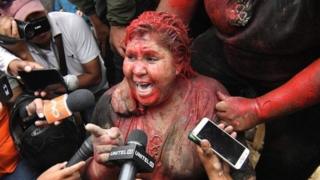 Image copyright
Image copyright
Reuters
Mr Iacocca, pictured at a Chrysler briefing in 1991
Lee Iacocca, the car industry legend who created the iconic Ford Mustang and saved Chrysler from bankruptcy, has died at the age of 94.
He died at his home in Los Angeles from complications from Parkinson’s disease, a family spokeswoman told US media.
Mr Iacocca is also remembered for his appearances in Chrysler ads in the US, pointing at viewers and telling them: “If you find a better car, buy it!”
In a statement, the company said it was “saddened” by the news of his death.
“He played a historic role in steering Chrysler through crisis and making it a true competitive force. He was one of the great leaders of our company and the auto industry as a whole,” the firm, which is now known as Fiat Chrysler Automobiles (FCA), said.
“Lee gave us a mindset that still drives us today – one that is characterised by hard work, dedication and grit.”
Creating America’s most iconic car
Born to Italian immigrant parents in Allentown, Pennsylvania in 1924, Mr Iacocca began his career as an engineer at the Ford Motor Company in 1946, before later moving into sales.
He had a natural flair for marketing, and his first campaign in the mid-1950s caught the eye of the company’s executives. Shortly afterwards, he was relocated to its headquarters in Dearborn, Michigan.
In 1964 he cemented his place in history by designing and launching the Ford Mustang, which sold 419,000 in its first year and would later become known one of America’s most iconic cars.
However, he was fired by the company in 1978 after being accused of plotting to oust Chairman Henry Ford II and take over his position.
You might also like:
But a year later, in 1979, Mr Iacocca took over Chrysler Corporation. The company was on the verge of collapse, and so he led it through a strict restructuring process that included taking a $1.5 billion government bailout (£1.2bn at current exchange rates). Mr Iacocca famously accepted a salary of just $1 a year while the company was recovering.
It eventually paid off. In 1983, he announced with pride that they were repaying the government loans seven years early.
But the sheen started to fade at the end of the decade, when the company once again took a downturn, and thousands of workers were laid off. When it became profitable again in 1992, Mr Iacocca left the firm.
Mr Iacocca was married three times. His first wife, Mary, died of diabetes in 1983 – something that prompted him to open a family foundation to fight the condition.












